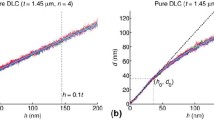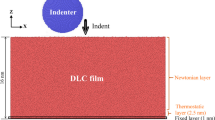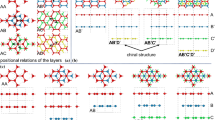Abstract
The hardness of the carbon nanotubes (CNTs)-doped diamond-like carbon (DLC) films is modeled by a nanoindentation finite element analysis. A three-dimensional (3D) formation where CNTs are modeled as transverse isotropy is compared with a two-dimensional (2D) analysis with isotropic CNTs. The results showed that for small CNTs volume fraction, the overall hardness of CNTs/DLC/Si composites is controlled by the elastic modulus along the indentation direction. For vertical CNTs-doped DLC films, the hardness in 3D analysis is close to that in 2D analysis if the isotropic elastic modulus is taken as the long-axis direction. However, for horizontal CNTs-doped DLC films, the hardness in 3D and in 2D is similar if the 2D isotropic elastic modulus is taken as the short-axis direction of the 3D elastic modulus. As a result, for small CNTs volume fraction, the hardness of CNTs/DLC/Si composites can be modeled by a 2D isotropic inclusion as long as the elastic modulus is chosen properly. The hardness in CNTs/DLC/Si composites depends on the orientation of CNTs and the volume fraction. The mechanisms in hardness enhancement for different CNT orientations are explained by shear stress and the effective projected area. The issues like interface strength and indentation size effect are also addressed in terms of CNT orientations.














Similar content being viewed by others
References
J. Salvetat-Delmotte and A. Rubio: Mechanical properties of carbon nanotubes: A fiber digest for beginners. Carbon 40, 1729 (2002).
E. Saether, S.J. Frankland, and R.B. Pipes: Transverse mechanical properties of single-walled carbon nanotube crystals. Part I: Determination of elastic moduli. Compos. Sci. Technol. 63, 1543 (2003).
Ph. Mauron, Ch. Emmenegger, A. Zuttel, Ch. Nutzenadel, P. Sudan, and L. Schlapbach: Synthesis of oriented nanotube films by chemical vapor deposition. Carbon 40, 1339 (2002).
L. Valentini, J. Biagiotti, J.M. Kenny, and S. Santucci: Morphological characterization of single-walled carbon nanotubes-PP composites. Compos. Sci. Technol. 63, 1149 (2003).
W. Chen, J. Tu, L. Wang, H. Gan, Z. Xu, and X. Zhang: Tribological application of carbon nanotubes in a metal-based composite coating and composites. Carbon 41, 215 (2003).
R. Zhong, H. Cong, and P. Hou: Fabrication of nano-Al based composites reinforced by single-walled carbon nanotubes. Carbon 41, 848 (2003).
Z. Xia, L. Riester, W.A. Curtin, H. Li, B.W. Sheldon, J. Liang, B. Chang, and J.M. Xu: Direct observation of toughening mechanisms in carbon nanotube ceramic-matrix composites. Acta Mater. 52, 931 (2004).
H. Kinoshita, I. Ippei, H. Sakai, and N. Ohmae: Synthesis and mechanical properties of carbon nanotube/diamond-like carbon composite films. Diamond Relat. Mater. 16, 1940 (2007).
C. Wei, C-I. Wang, F.C. Tai, K. Ting, and R.C. Chang: The effect of CNT content on the surface and mechanical properties of CNTs doped diamond like carbon films. Diamond Relat. Mater. 19, 562 (2010).
H. Hu, G. Chen, and J. Zhang: Facile synthesis of CNTs-doped diamond-like carbon film by electrodeposition. Surf. Coat. Technol. 202, 5943 (2008).
W.C. Oliver and G.M. Pharr: An improved technique for determining hardness and elastic modulus using load and displacement sensing indentation experiments. J. Mater. Res. 7, 1564 (1992).
C. Wei and J-F. Yang: A finite element analysis on the effects of residual stress, substrate roughness and non-uniform stress distribution on the mechanical properties of diamond-like carbon films. Diamond Relat. Mater. 20, 839 (2011).
X. Cai and H. Bangert: Finite element analysis of the interface influence on the hardness measurement of thin films. Surf. Coat. Technol. 81, 240 (1996).
K. Sangwal: Review: Indentation size effect, indentation cracks and microhardness measurement of brittle crystalline solids–some basic concepts and trends. Cryst. Res. Technol. 44, 1019 (2009).
D. Chicot: Hardness length-scale factor to model nano- and micro-indentation size effects. Mater. Sci. Eng., A 499, 454 (2009).
K. Sangwal, B. Surowska, and P. Blaziak: Analysis of the indentation size effect in the microhardness measurement of some cobalt-based alloy. Mater. Chem. Phys. 77, 511 (2002).
T. Ebisu and S. Horibe: Analysis of the indentation size effect in brittle materials from nanoindentation load-displacement curve. J. Eur. Ceram. Soc. 30, 2419 (2010).
Q. Ma and D.R. Clarke: Size dependent hardness of silver single crystals. J. Mater. Res. 10, 853 (1995).
W.D. Nix and H. Gao: Indentation size effects in crystalline materials: A law for strain gradient plasticity. J. Mech. Phys. Solids 46, 411 (1998).
Acknowledgment
Financial support provided by the National Science Council of ROC under grant NSC-99-2221-E-036-005 is gratefully acknowledged.
Author information
Authors and Affiliations
Corresponding author
Rights and permissions
About this article
Cite this article
Wei, C., Yang, JF. A finite element study on the hardness of carbon nanotubes-doped diamond-like carbon film. Journal of Materials Research 27, 330–338 (2012). https://doi.org/10.1557/jmr.2011.331
Received:
Accepted:
Published:
Issue Date:
DOI: https://doi.org/10.1557/jmr.2011.331




